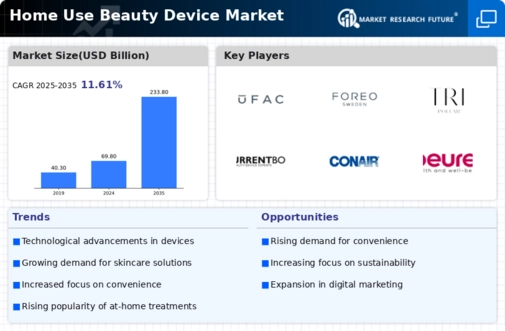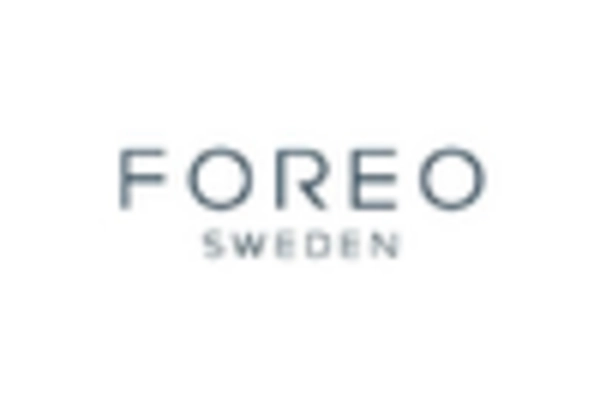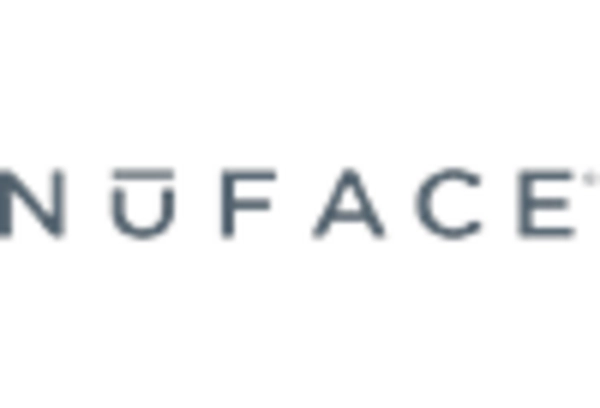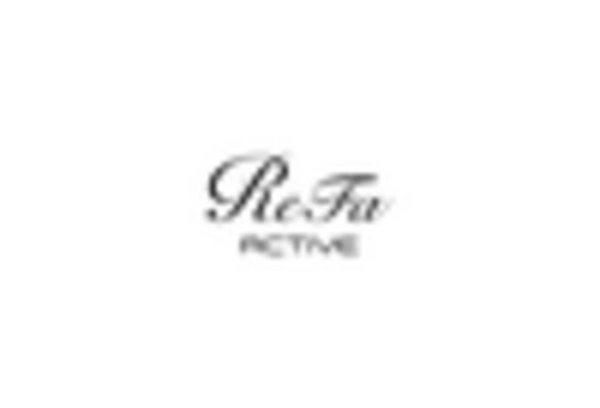The Home Use Beauty Device Market is currently characterized by a dynamic competitive landscape, driven by innovation, consumer demand for convenience, and the increasing integration of technology in personal care. Key players such as NuFace (US), Foreo (SE), and Philips (NL) are at the forefront, each adopting distinct strategies to enhance their market presence. NuFace (US) focuses on innovation in microcurrent technology, aiming to provide effective anti-aging solutions, while Foreo (SE) emphasizes the use of silicone in its cleansing devices, promoting hygiene and ease of use. Philips (NL) leverages its extensive experience in health technology to offer a range of beauty devices that integrate wellness and beauty, thus appealing to health-conscious consumers. Collectively, these strategies contribute to a competitive environment that prioritizes technological advancement and consumer-centric product development.
In terms of business tactics, companies are increasingly localizing manufacturing to reduce costs and enhance supply chain efficiency. This approach appears to be particularly relevant in the context of the Home Use Beauty Device Market, which is moderately fragmented, with several players vying for market share. The collective influence of these key players shapes a landscape where innovation and operational efficiency are paramount, allowing companies to respond swiftly to changing consumer preferences.
In August 2025, NuFace (US) launched a new line of at-home facial devices that incorporate AI technology to personalize skincare routines. This strategic move not only positions NuFace as a leader in technological integration but also caters to the growing consumer demand for personalized beauty solutions. The introduction of AI-driven devices may significantly enhance user engagement and satisfaction, potentially leading to increased brand loyalty.
In September 2025, Foreo (SE) announced a partnership with a leading skincare brand to co-develop a new line of beauty devices that utilize advanced sonic technology. This collaboration is indicative of a broader trend towards strategic alliances in the industry, allowing Foreo to leverage the skincare brand's expertise while expanding its product offerings. Such partnerships may enhance product credibility and attract a wider consumer base, thereby strengthening Foreo's market position.
In July 2025, Philips (NL) unveiled a new sustainability initiative aimed at reducing the environmental impact of its beauty devices. This initiative includes the use of recyclable materials and energy-efficient manufacturing processes. By prioritizing sustainability, Philips not only addresses growing consumer concerns regarding environmental responsibility but also differentiates itself in a competitive market increasingly focused on eco-friendly practices.
As of October 2025, the Home Use Beauty Device Market is witnessing trends that emphasize digitalization, sustainability, and the integration of artificial intelligence. Strategic alliances are becoming increasingly prevalent, shaping a landscape where collaboration enhances innovation and market reach. Looking ahead, competitive differentiation is likely to evolve, with a shift from price-based competition to a focus on technological innovation, product quality, and supply chain reliability. Companies that can effectively navigate these trends will likely secure a competitive edge in this rapidly evolving market.

















Leave a Comment